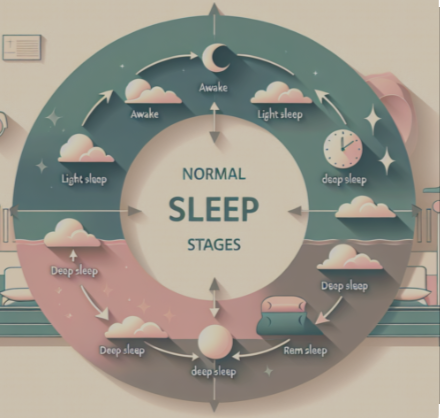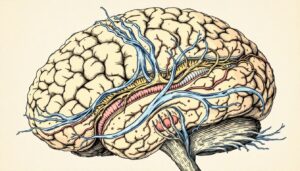What is Sleep and Why is it Important?
Sleep is a vital aspect of our overall health and well-being, playing a crucial role in physical and mental restoration. The field of sleep medicine has evolved to address a broad spectrum of sleep-related issues, emphasizing the importance of understanding and treating various sleep disorders.
During sleep, our body repairs and regenerates tissues, builds bone and muscle, and strengthens our immune system.
Sleep also helps to improve cognitive function, including attention, memory, and problem-solving skills.
The Sleep Cycle: An Overview
A sleep cycle typically lasts around 90-120 minutes and includes four or five cycles per night.
Each cycle consists of different sleep stages, including NREM and REM sleep. Sleep medicine physicians play a crucial role in diagnosing and treating sleep disorders by understanding the intricacies of the sleep cycle.
The sleep cycle is regulated by the body’s internal clock, also known as the circadian rhythm.
Stage 2 sleep is characterized by the presence of sleep spindles, which are brief bursts of neuronal activity that play a role in memory consolidation and synaptic plasticity.
NREM Sleep (Non-REM Sleep)
NREM sleep is characterized by slow brain waves, low body temperature, and reduced muscle activity.
Advancements in sleep medicine have provided deeper insights into the characteristics and importance of NREM sleep.
NREM sleep is further divided into three stages, each sleep stage with distinct brain wave patterns and levels of consciousness.
Stage 1: Light Sleep
Stage 1 is the lightest stage of sleep, lasting around 5-10 minutes.
During this stage, brain waves slow down, and the body becomes less responsive to external stimuli.
It is easy to wake up during this stage, and it is often considered a transition phase between wakefulness and sleep. Sleep medicine research has highlighted the significance of light sleep in the overall sleep architecture.
Stage 3: Deep Sleep
Stage 3 is the deep sleep stage, also known as slow wave sleep.
During this stage, brain waves slow down even further, and the body becomes less responsive to external stimuli.
Deep sleep is essential for physical restoration, including the repair and regeneration of tissues. The field of sleep medicine has underscored the critical role of deep sleep in physical restoration and overall health.
REM Sleep (Rapid Eye Movement)
REM sleep is characterized by rapid eye movement, increased brain activity, and vivid dreams.
REM sleep is essential for mental restoration, including the processing and consolidation of memories. Sleep medicine has been instrumental in uncovering the complexities of REM sleep and its impact on mental health.
Eye Movement REM Sleep
Eye movement REM sleep is the stage of REM sleep where the eyes move rapidly and randomly.
During this stage, brain activity is similar to that of being awake, and dreams are often vivid and intense. Research in sleep medicine has provided valuable insights into the significance of eye movements during REM sleep.
Circadian Rhythms and Their Role in Sleep
Circadian rhythms are internal biological processes that occur in living organisms, including humans, and are influenced by light and darkness. At the heart of this system is the suprachiasmatic nucleus (SCN) in the hypothalamus, which acts as the master biological clock. The SCN responds to light and dark signals from the environment, synchronizing the body’s physiological processes with the 24-hour day-night cycle.
The circadian rhythm plays a crucial role in regulating the sleep-wake cycle by affecting the release of hormones such as melatonin and cortisol. Melatonin levels typically rise in the evening, promoting sleep, and decrease in the morning, allowing for wakefulness. Conversely, cortisol levels peak in the morning to help us wake up and gradually decline throughout the day.
Exposure to natural light during the day helps regulate the circadian rhythm, while exposure to artificial light, especially blue light from electronic screens, in the evening can disrupt it. Irregularities in the circadian rhythm can lead to sleep disorders such as delayed sleep phase syndrome, advanced sleep phase disorder, and non-24-hour sleep-wake disorder. Understanding and maintaining a healthy circadian rhythm is essential for achieving restful sleep and overall well-being. Sleep medicine has advanced our understanding of circadian rhythm disorders and their impact on sleep quality.
Sleep Architecture
Sleep architecture refers to the intricate pattern and structure of our sleep, encompassing the various stages of sleep and their duration throughout the night. Each sleep cycle is composed of different stages, including NREM and REM sleep, which repeat several times during a typical night. Understanding sleep architecture is crucial for diagnosing and treating sleep disorders, as disruptions in the normal pattern can indicate underlying issues.
In a healthy sleep architecture, we transition smoothly through the stages of sleep, starting with light sleep, moving into deeper sleep stages, and finally entering REM sleep. Each stage of sleep plays a unique role in our overall health. For instance, light sleep serves as a transition phase, while deep sleep is vital for physical restoration, and REM sleep is essential for cognitive functions like memory consolidation.
Disruptions in sleep architecture, such as frequent awakenings or an imbalance in the duration of different sleep stages, can lead to sleep disorders. Conditions like obstructive sleep apnea, insomnia, and restless leg syndrome can significantly alter sleep architecture, resulting in fragmented sleep and reduced sleep quality. By understanding and monitoring sleep architecture, healthcare professionals can better diagnose sleep disorders and develop effective treatment plans to restore healthy sleep patterns.
The REM Cycle: How Much Sleep Do We Need?
The amount of REM sleep we need varies across the lifespan, with infants and young children requiring more REM sleep than adults. Understanding the stages of sleep, including both NREM and REM sleep, is crucial for determining how much restorative sleep we need. Adults typically need 7-9 hours of sleep per night, with 20-25% of that time spent in REM sleep. Sleep medicine has been pivotal in establishing guidelines for sleep requirements across different age groups.
Getting More REM Sleep
Getting more REM sleep can be achieved by establishing a consistent sleep schedule, avoiding caffeine and electronics before bedtime, and creating a relaxing sleep environment.
Practicing relaxation techniques, such as meditation or deep breathing, can also help to increase REM sleep. Sleep medicine experts recommend these practices to enhance sleep quality and increase REM sleep.
Impact of Lifestyle on Sleep Cycles
Lifestyle factors, such as physical activity, diet, and stress levels, can significantly impact sleep cycles. Regular physical activity can help improve sleep quality, but it’s important to avoid vigorous exercise within a few hours of bedtime, as it can disrupt sleep. A balanced diet that includes foods rich in tryptophan, such as turkey and fish, can promote sleep by aiding in the production of melatonin.
Avoiding caffeine, nicotine, and heavy meals close to bedtime can also help improve sleep quality. These substances can interfere with the ability to fall asleep and stay asleep, leading to fragmented sleep cycles. Stress management techniques, such as meditation and deep breathing, can help reduce stress levels and promote relaxation before sleep, making it easier to fall asleep and stay asleep.
Exposure to electronic screens and the blue light they emit can suppress melatonin production and disrupt sleep. To mitigate this, it’s advisable to limit screen time before bed and create a relaxing sleep environment. Establishing a consistent sleep schedule, where you go to bed and wake up at the same time every day, can also help regulate your sleep cycles and improve overall sleep quality. Sleep medicine professionals often advise on lifestyle changes to improve sleep quality and regulate sleep cycles.
Sleep Disorders and Their Effect on Sleep Cycles
Sleep disorders, such as obstructive sleep apnea, insomnia, and restless leg syndrome, can significantly impact sleep cycles. Obstructive sleep apnea causes repeated awakenings during the night due to blocked airways, disrupting the normal sleep cycle and leading to fragmented sleep. This can result in excessive daytime sleepiness and other health issues.
Insomnia, characterized by difficulty falling asleep or staying asleep, can also lead to fragmented sleep cycles. This condition often results in insufficient sleep and can negatively affect cognitive function, mood, and overall health. Restless leg syndrome causes discomfort and movement during sleep, further disrupting the normal sleep cycle and leading to sleep deprivation.
Sleep deprivation can have serious consequences, including impaired cognitive function, mood disturbances, and an increased risk of chronic diseases. Sleep disorders can also affect the immune system, leading to increased inflammation and oxidative stress. Treatment of sleep disorders often involves a combination of lifestyle changes, behavioral therapies, and pharmacological interventions. Addressing these disorders is crucial for restoring healthy sleep cycles and improving overall well-being. The field of sleep medicine is dedicated to diagnosing and treating sleep disorders to restore healthy sleep cycles.
Sleep and Mental Health
Sleep is closely linked to mental health, with sleep disorder such as insomnia and sleep apnea contributing to conditions like depression and anxiety.
Getting adequate sleep is essential for maintaining good mental health, and addressing sleep disorders can help to alleviate symptoms of mental health conditions. Sleep medicine plays a crucial role in addressing sleep disorders to improve mental health outcomes.
Conclusion
- Understanding the different sleep cycles and stages is essential for maintaining good sleep hygiene and overall health.
- By prioritizing sleep and addressing sleep disorders, we can improve our physical and mental well-being, and reduce the risk of chronic diseases.









